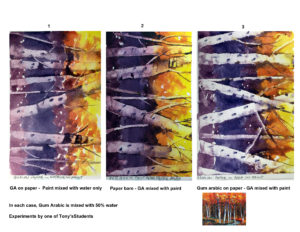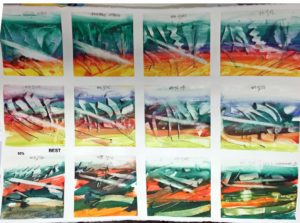Some Important Concepts for Watercolor
These are a few of the principles to become aware of and to master in watercolor. They exist in all painting mediums. They are somewhat special in watercolor, partly because of its ‘transparent’ nature. It is necessary to plan the execution – a good skill to carry to oils or acrylics.
The ‘Dance of the Whites’: It is important to understand that “White” or “light” shapes generally have to be planned for at the outset vs being added on at the end of a painting as often with oils/acrylics (even though this can be done in some cases using lift-out techniques or even opaque whites).
Gesture: Like the miming gestures one might make with the hands and arms when describing, for example, a vase of flowers or a building. Gesture is an important type of energy in a painting. You can practice the gesture to give it ‘integrity’.
Contours & Edges: Every shape has outlines, usually created by the contrasting value of edges, but sometimes literally drawn with ink or brush. Edges can be hard or soft. EDGE QUALITY is important. Some styles allow for drawing outlines. Try to draw these after painting the shapes for a looser look vs ‘coloring book’.
2D Shape: Shape-Making is an important skill. This is different from drawing outlines and ‘coloring in’. Think of it as ‘silhouette-making’. Silhouettes are perhaps the most important aspect of form.
Positive-Negative: There are Positive vs Negative shapes…both are important. A strong design needs strong negatives, as well as positive shapes. Positives are easily seen – Learning to work with the negative shapes is a more difficult skill. The positive 2D silhouette-shape is like the shape of a leaf or cloud (it seems to be the subject and often has a name or geometry). The negative 2D silhouette-shape is just the shape between leaves or clouds (between the main subjects and usually has no particular name). Aim to make Positive Shapes and Negative Shapes equal partners in a painting – like the yin-yang symbol..
Figure Ground Relationship: A shape has 3 main ways to contrast with the background using tone: darker than, lighter than or transitional (part darker and part lighter). The ‘transition’ is also called a “figure-ground reversal”. You take control and choose in any situation.
Color: Maintaining luminosity – There are ‘sedimentary’(relatively opaque) pigments and ‘transparent’ pigments. The test is to make a wide black felt pen line and paint the colors across it. If you can see the frosted pigments on the black line, they are sedimentary, if not…transparent. Most people like the ‘transparent’ look, so chose transparent colours at the outset, but some of the opaques are very alluring. Yellows are usually sedimentary, though aureolin is transparent , but not very rich. It’s always a compromise.
Paints: First master working with a limited palette, red, yellow, blue (and perhaps green). Then expand later.
Color Contrasts: There are 3 main ways colors contrast: tonality, saturation, hue.
Tonality: You can learn a lot by working from photos, but best to work from photos you have taken yourself. Avoid copyright issues! If you work from a color photo try to see it as black and white. Translate a continuous toned image into 3 or 4 tonal values. The lights give SPARKLE. The darks give IMPACT. The mid-tones give SUBTLETY and richness. Thinking this way helps you create a ‘tonal design’ versus a mere ‘documentation’.
Composition: Apply an ordering concept, a ‘design’, to the elements in the picture. There are many traditional systems, or you may create one of your own through observation or informed intuition. This involves proportion, scale, format, cropping, focal points, placement, eye path, dominance, balance, numbers, rhythm, hierarchy of shapes, and other general design principles. You should make a deliberate study of composition – you get better very slowly if you just look at your own paintings.

